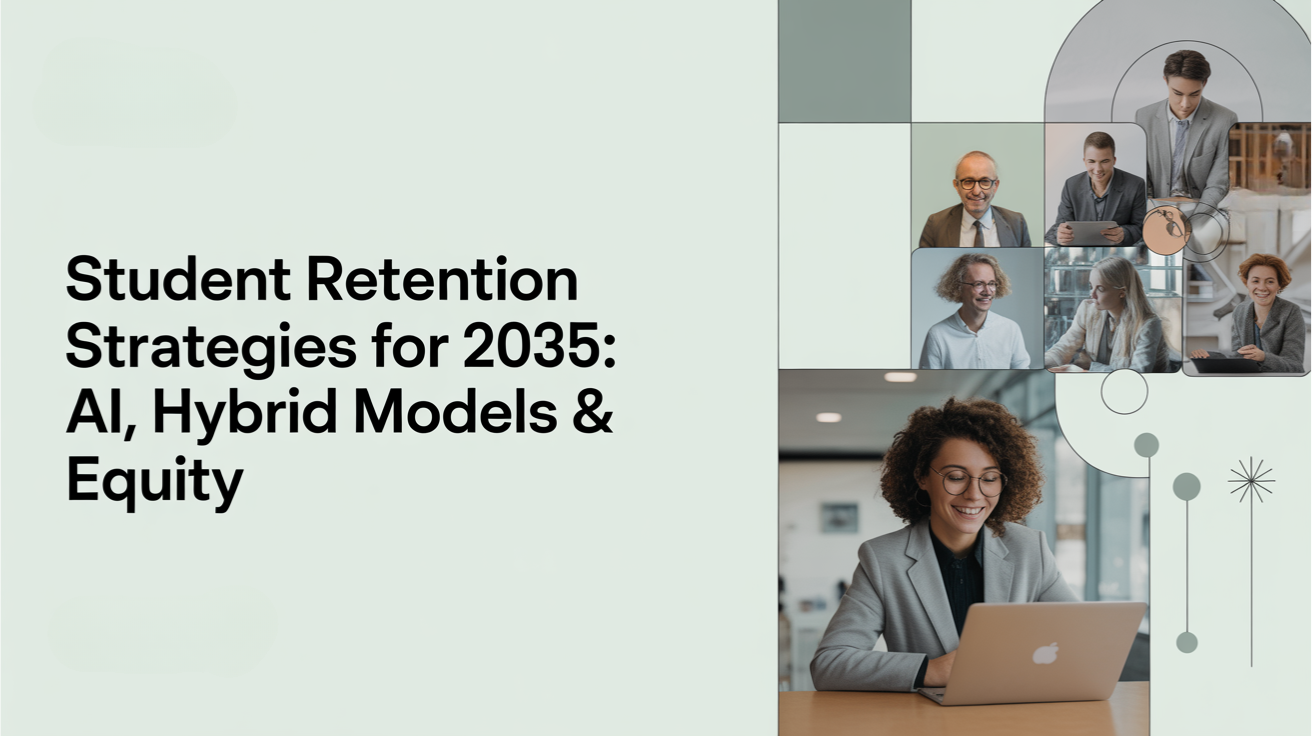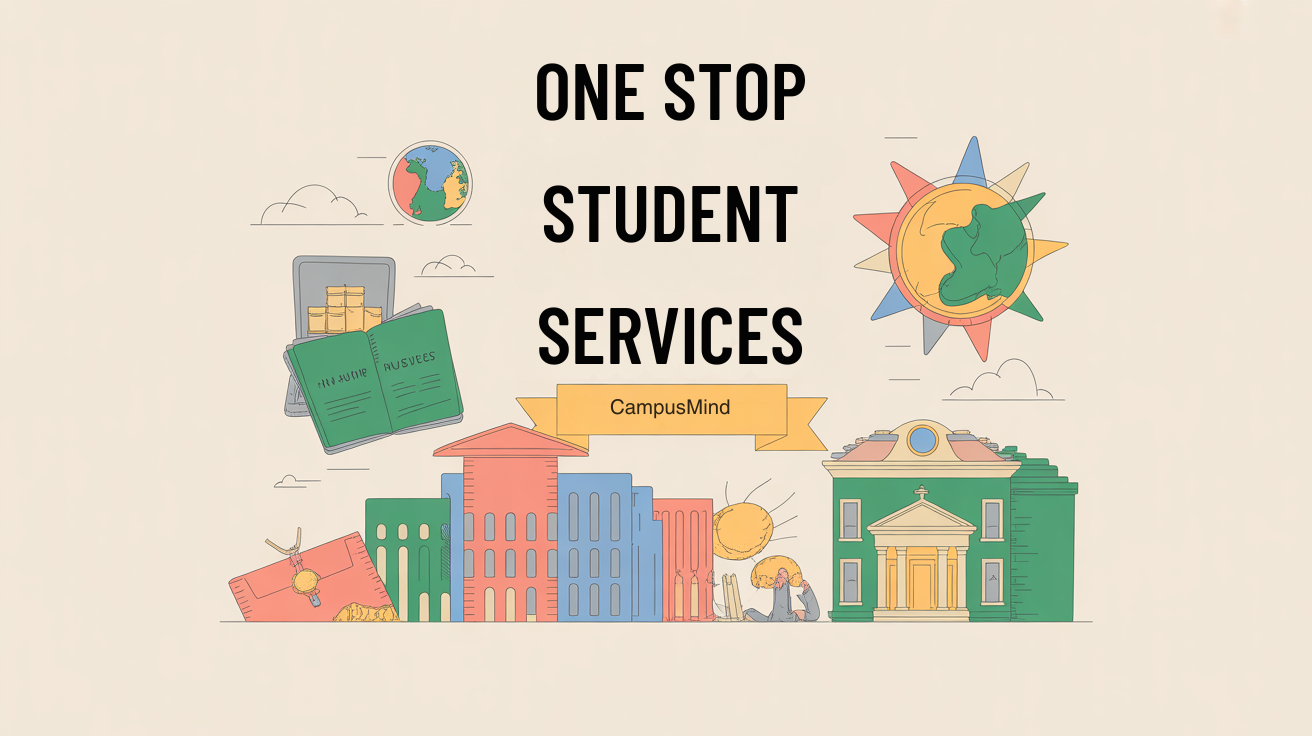The future of student retention strategies through 2035 will be shaped by demographic shifts, AI-driven personalized support, hybrid learning models, and lifelong education pathways. Campus leadership must invest in data infrastructure, equity-focused strategies, and adaptive systems to sustain enrollment and student success.
Introduction: Preparing for a Transformed Higher Education Landscape
Campus leadership stands at a pivotal moment. The convergence of demographic decline, technological transformation, and evolving student expectations is reshaping the future of student retention strategies in higher education. By 2035, the landscape of student success initiatives will look fundamentally different from today's approaches.
The enrollment cliff—projected to reduce high school graduates from 3.9 million in 2025 to 3.4 million by 2041—demands that institutions shift their focus from recruitment volume to retention excellence. At the same time, technological advances in artificial intelligence and the rise of lifelong learning models offer unprecedented opportunities to support diverse student populations more effectively.
This article explores the future of student retention strategies through 2035, examining how campus leadership can position their institutions to thrive despite demographic headwinds while advancing equity and student belonging.
The Demographic Reality: Beyond Traditional Student Pipelines
Understanding the Enrollment Cliff Timeline
Recent projections from the Western Interstate Commission for Higher Education confirm that 2025 marks the peak of high school graduates in the United States, with approximately 3.9 million students. This figure represents a 13 percent decline by 2041, creating sustained pressure on institutional enrollment.
The demographic decline stems from reduced birth rates following the 2008 recession, creating what experts describe as a structural constraint rather than a temporary fluctuation. Moreover, Census Bureau projections reveal not one but two demographic cliffs—the first between 2026 and 2030, followed by a second drop from 2033 to 2039.
Regional Variations and Institutional Impact
The enrollment cliff will not affect all regions equally. Northeast and Midwest institutions face the steepest declines, with some states projecting drops exceeding 15 percent. Conversely, Texas and several Mountain West states may see modest growth, creating new competitive dynamics.
Small and mid-sized institutions face the greatest financial vulnerability. Since 2016, more than 120 colleges have closed or merged, with projections suggesting an 8.1 percent increase in annual closures as enrollment pressures intensify. For campus leadership, the message is clear: student retention strategies must become the primary enrollment strategy.
AI-Driven Personalized Support: Scaling the Socratic Ideal

The Rise of Intelligent Tutoring Systems
Artificial intelligence is transforming personalized support from an aspirational ideal into operational reality. By 2025, 57 percent of higher education institutions are prioritizing AI integration—up from 49 percent just one year earlier. This rapid adoption reflects AI's potential to deliver what was once impossible: a personal tutor for every student.
Intelligent tutoring systems have demonstrated the capacity to improve student performance by 20 percent through adaptive learning pathways that adjust to individual pace, learning style, and knowledge gaps. These systems provide immediate feedback, identify misconceptions before they become entrenched, and offer round-the-clock support without the staffing constraints that limit traditional advising models.
Early Intervention and Predictive Analytics
The future of retention depends on shifting from reactive interventions to proactive support. AI-powered analytics can synthesize data from learning management systems, participation in campus resources, and engagement patterns to identify students at risk of disengagement weeks or months before they would appear on traditional early-alert lists.
These data-driven insights enable campus leadership to allocate resources more effectively, targeting real-time, personalized support to students who need it most. By integrating AI with human advising, institutions can scale their capacity to provide timely interventions while preserving the personal connections that foster student belonging.
Hybrid Learning Models: Flexibility Meets Belonging
The Post-Pandemic Shift to Blended Approaches
The full transition to hybrid learning models is already underway, with research indicating that the majority of students by 2025 will combine on-ground and online experiences through blended formats. This shift reflects student demand for flexibility while maintaining the social connection and campus engagement that support persistence.
By 2030, hybrid campuses will be the norm rather than the exception. These environments leverage technology to expand access, offering synchronous and asynchronous options that accommodate working students, commuters, and adult learners who require flexible pathways. Virtual reality and augmented reality technologies will further enhance engagement, creating immersive learning experiences that transcend physical limitations.
Balancing Scale and Personalization
The challenge for campus leadership is maintaining student wellbeing and belonging in increasingly hybrid environments. Research shows that millennial parents—whose children will be the students of 2030-2035—are open to hybrid approaches but emphasize the need for standards and intentional design to prevent isolation.
Successful hybrid models integrate regular touchpoints, peer collaboration opportunities, and structured community-building alongside flexible digital access. Campus resources must be reimagined to operate seamlessly across physical and virtual spaces, ensuring that all students feel connected to campus life regardless of their mode of attendance.
Lifelong Learning: The 60-Year Curriculum
Rethinking the Traditional Degree Timeline
By 2035, higher education will be defined by continuous, lifelong learning rather than one-time degrees. The emerging 60-year curriculum model positions student retention strategies to extend beyond traditional undergraduates to include adult learners, returning professionals, and career changers.
Micro-credentials, flexible online programs, and recognition of prior learning will help institutions serve this growing market. As the global lifelong learning economy expands by nearly $1 trillion by 2030, effective student retention strategies will ensure learners remain engaged through every career stage.
Micro-Credentials and Flexible Pathways
The UNESCO Sustainable Development Goal 4 calls for ensuring inclusive and equitable quality education and promoting lifelong learning opportunities for all by 2030. Higher education institutions must evolve into beacons of lifelong learning, offering stackable credentials, certificate programs, and modular courses that allow learners to build competencies incrementally.
The UNESCO Sustainable Development Goal 4 calls for ensuring inclusive and equitable quality education and promoting lifelong learning opportunities for all by 2030. Higher education institutions must evolve into beacons of lifelong learning, offering stackable credentials, certificate programs, and modular courses that allow learners to build competencies incrementally.
Advancing Equity: Retention 2035 as a Justice Issue
Disaggregating Data to Close Completion Gaps
As student demographics diversify, equity-centered student retention strategies become essential. Institutions must disaggregate data to uncover completion gaps among racial, socioeconomic, and first-generation groups.
AI tools must also be audited for algorithmic bias to ensure fairness in predictive models. When implemented ethically, AI can enhance equity-focused student retention strategies, ensuring all learners receive the support they need to succeed.
AI and Algorithmic Equity
While AI offers powerful tools for personalization, campus leadership must remain vigilant about algorithmic bias. Predictive models trained on historical data can replicate existing inequities if not carefully designed and monitored. Institutions must ensure that AI-driven systems enhance rather than undermine equity goals, combining automated insights with human judgment and cultural competence.
No-Regrets Moves: Strategic Actions for Campus Leadership

Investing in Data Infrastructure
Regardless of future uncertainties, robust data infrastructure is essential. Institutions need integrated systems that connect learning management platforms, student information systems, and engagement tracking to provide a comprehensive view of each student's experience. This foundation enables both AI-powered analytics and human advisors to identify and support students effectively.
Building a Culture of Care
Technology alone cannot ensure student success. The future of retention rests on a culture where faculty, staff, and campus leadership prioritize student wellbeing, belonging, and holistic development. This means training faculty in trauma-informed pedagogy, expanding mental health resources, and ensuring that every student has at least one meaningful connection to an adult on campus.
Cultivating Institutional Agility
The pace of change through 2035 will require institutions to iterate rapidly, test innovations, and adapt based on outcomes. Campus leadership should foster a culture of experimentation, allocating resources for pilot programs while building assessment capacity to determine what works for their specific student populations.
Policy Wildcards: Preparing for External Disruptions
Several policy factors could significantly alter retention dynamics by 2035. Changes to federal financial aid, immigration policies affecting international student enrollment, and state-level funding models all present variables beyond institutional control. Recent disruptions to international student visas, for example, have already cost institutions billions in tuition revenue.
Campus leadership must develop scenario-planning capabilities, preparing contingency strategies for multiple possible futures. This includes diversifying revenue sources, building financial reserves, and cultivating relationships with policymakers to advocate for supportive frameworks.
Conclusion: The Future of Retention Starts Now
The future of retention through 2035 will be defined by institutions that act decisively today. Demographic pressures are intensifying, but technology, hybrid models, lifelong learning pathways, and equity-focused strategies offer viable paths forward.
Campus leadership must recognize that retention is no longer just about keeping students enrolled—it's about creating adaptive, student-centered systems that support diverse learners throughout their educational journeys. By investing in data-driven insights, AI-powered personalization, flexible learning environments, and cultures of care, institutions can position themselves to thrive in a transformed higher education landscape.
The enrollment cliff is real, but it also presents an opportunity: to reimagine student success for a new era, ensuring that higher education remains accessible, equitable, and relevant for generations to come.
Ready to transform your approach to student retention?
Learn more about Campus Mind's data-driven engagement platform
FAQs
Q1: What is the enrollment cliff and how will it affect retention strategies?
The enrollment cliff refers to the projected decline in high school graduates from a peak of 3.9 million in 2025 to 3.4 million by 2041—a 13 percent decrease. This demographic shift, driven by reduced birth rates after the 2008 recession, forces institutions to prioritize retention over recruitment. Campus leadership must focus on keeping enrolled students engaged, supported, and on-track to graduation rather than relying solely on attracting new applicants. This requires investing in data infrastructure, early intervention systems, and personalized support that addresses academic, social, and basic needs barriers to student success.
Q2: How will artificial intelligence transform student retention by 2035?
AI will enable personalized support at scale through intelligent tutoring systems that adapt to individual learning styles, predictive analytics that identify at-risk students before they disengage, and 24/7 virtual advisors that provide immediate assistance. By 2025, 57 percent of institutions already prioritize AI integration, and by 2035, AI-driven systems will be standard practice. These technologies can improve student performance by 20 percent while freeing human advisors to focus on complex cases requiring empathy and cultural competence. However, campus leadership must ensure AI systems are monitored for algorithmic bias and designed to enhance equity rather than replicate existing disparities.
Q3: What is the 60-year curriculum and why does it matter for retention?
The 60-year curriculum recognizes that individuals will need continuous reskilling approximately every five years throughout careers spanning 60 to 80 years. This shift transforms higher education from a one-time degree experience into lifelong learning pathways. For retention, this means institutions can serve adult learners, career changers, and returning students through stackable credentials, micro-credentials, and flexible online programs. The global lifelong learning market is projected to grow by 990 billion dollars by 2030, offering institutions a strategic opportunity to offset declining traditional enrollments while fulfilling urgent workforce development needs.
Q4: How can institutions balance hybrid learning with student belonging?
Successful hybrid models intentionally design opportunities for connection, community, and belonging alongside flexible digital access. Research shows students want flexibility but also value social interaction and campus engagement. Institutions should offer synchronous collaboration sessions, peer mentoring programs, and regular check-ins that maintain human connection. Technology should enhance rather than replace relationships, using virtual reality and augmented reality to create immersive shared experiences. Campus resources—advising, mental health support, career services—must operate seamlessly across physical and digital spaces, ensuring all students feel welcomed and supported regardless of their attendance mode.
Q5: What are no-regrets moves campus leadership should make now?
Campus leadership should immediately invest in three foundational areas regardless of future uncertainties. First, build robust data infrastructure that integrates learning management systems, student information systems, and engagement tracking to enable early intervention. Second, cultivate a culture of care through faculty training in trauma-informed pedagogy, expanded mental health resources, and ensuring every student has meaningful connections to campus. Third, develop institutional agility by allocating resources for pilot programs, building assessment capacity, and fostering experimentation. These strategic investments prepare institutions to respond effectively to demographic pressures while advancing equity and student success.
Works Cited
[1] Synario — "Higher Education Enrollment Cliff: Financial Perspective Is Everything." https://www.synario.com/resources/blog/enrollment-cliff/. Published: September 8, 2025. Accessed: October 24, 2025.
[2] CNBC — "'A perfect storm' — more colleges at risk as enrollment falls and financial pressures mount." https://www.cnbc.com/2025/09/30/colleges-at-risk.html. Published: September 30, 2025. Accessed: October 24, 2025.
[3] Texas A&M University System Data Science — "Projecting the Demographic Cliff: 18-Year-Olds and High School Graduates." https://www.tamus.edu/data-science/2025/03/01/projecting-the-demographic-cliff-18-year-olds-and-high-school-graduates/. Published: March 1, 2025. Accessed: October 24, 2025.
[4] Inside Higher Ed — "College-age demographics begin steady projected decline." https://www.insidehighered.com/news/admissions/traditional-age/2024/12/11/college-age-demographics-begin-steady-projected-decline. Published: December 11, 2024. Accessed: October 24, 2025.
[5] NPR/Hechinger Report — "A looming 'demographic cliff': Fewer college students and ultimately fewer graduates." https://www.npr.org/2025/01/08/nx-s1-5246200/demographic-cliff-fewer-college-students-mean-fewer-graduates. Published: January 8, 2025. Accessed: October 24, 2025.
[6] Workday — "AI in the Classroom: Personalized Learning and the Future of Education." https://blog.workday.com/en-us/ai-in-the-classroom-personalized-learning-and-the-future-of-education.html. Published: March 18, 2025. Accessed: October 24, 2025.
[7] MDPI Education Sciences — "The Impact of Artificial Intelligence (AI) on Students' Academic Development." https://www.mdpi.com/2227-7102/15/3/343. Published: March 11, 2025. Accessed: October 24, 2025.
[8] arXiv — "A Comprehensive Review of AI-based Intelligent Tutoring Systems: Applications and Challenges." https://arxiv.org/html/2507.18882v1. Published: July 25, 2025. Accessed: October 24, 2025.
[9] Fierce Network — "Future of Higher Education: Fully Shift to Hybrid Model by 2025." https://www.fierce-network.com/teaching-learning/future-higher-education-fully-shift-hybrid-model-2025. Published: August 11, 2022. Accessed: October 24, 2025.
[10] South African Journal of Higher Education — "2030: Future scenarios for learning and teaching models in higher education." https://www.journals.ac.za/sajhe/article/view/5974. Published: June 22, 2024. Accessed: October 24, 2025.
[11] Harvard Extension School — "Lifelong Learning: The Evolving Future of Higher Education." https://extension.harvard.edu/news/lifelong-learning-the-evolving-future-of-higher-education/. Published: December 4, 2023. Accessed: October 24, 2025.
[12] AACSB — "What Does the Future Hold for Lifelong Learning?" https://www.aacsb.edu/insights/articles/2024/06/what-does-the-future-hold-for-lifelong-learning. Published: September 16, 2024. Accessed: October 24, 2025.
[13] UNESCO — "What you need to know on lifelong learning." https://www.unesco.org/en/lifelong-learning/need-know. Published: February 13, 2025. Accessed: October 24, 2025.
[14] UNESCO Institute for Lifelong Learning — "Higher education institutions must evolve into beacons of lifelong learning." https://uil.unesco.org/higher-education-institutions-must-evolve-beacons-lifelong-learning. Published: June 5, 2023. Accessed: October 24, 2025.
[N1] Higher Ed Dive — "HEDive2025_demographics" (Referenced via fresh_hook_source_label in topic brief). Accessed: October 24, 2025.



